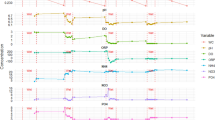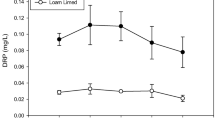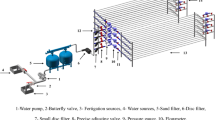Abstract
Potassium silicate drilling fluid (PSDF) is a relatively new type of drilling waste generated by the oil and gas industry. PSDF effects on soil, vegetation, and ground water must be determined before its land disposal and use in reclamation can be regulated. A laboratory column leachate study was conducted to quantify the response of select soil and leachate properties to PSDF at various depths in soil column profiles. A spent PSDF was applied to two soils (sand and loam textures) at four rates (20, 40, 60, 120 m3 ha−1) with two application methods (incorporated, sprayed). Changes to soil and leachate properties were at values that would not be detrimental to most plant species when PSDF was applied at ≤60 m3 ha−1. Applying PSDF at 120 m3 ha−1 had significant effects on soil properties and leachate quality. Hydraulic conductivity and field capacity were significantly reduced, and soil available potassium and sulfate concentrations, pH, and salinity increased with PSDF. Incorporated PSDF in the upper 10 cm of soil accelerated PSDF element transport through soil columns to leachate and increased organic carbon and salinity in leachate. PSDF application rate significantly reduced soil field capacity, available nitrogen, and increased salinity at the highest rates in loam soil, suggesting a threshold beyond which conditions will not be suitable for land spraying PSDF. This research demonstrates that PSDF has potential to improve soil short term water availability, macronutrient potassium and sulfur for disposal on cultivated and uncultivated lands. This potential should be field tested.




Similar content being viewed by others
References
Alberta Agriculture, Food and Rural Development. (1987). Soil quality criteria relative to disturbance and reclamation. Edmonton: Conservation and Development Branch.
Alberta Energy Resources Conservation Board. (2012). Directive 050: drilling waste management. Calgary: Alberta Energy Resources Conservation Board.
Alberta Environment Sustainable Resource Development. (2010). Alberta tier 1 soil and groundwater remediation guidelines. Edmonton: Alberta Environment and Sustainable Resource Development.
Alberta Ministry of Energy. (2013). The ministry of energy annual report (2012–2013). Edmonton: Ministry of Energy.
Anoliefo, G. O., Isikhuemhen, O. S., & Ohimain, E. I. (2006). Sensitivity studies of the common bean (Vigna unguiculata) and maize (Zea mays) to different soil types from the crude oil drilling site at Kutchalli, Nigeria. Journal of Soils and Sediments, 6(1), 30–36.
APHA (1999). Standard methods for the examination of water and wastewater (3120B). American Public Health Association (APHA). http://www.mwa.co.th/download/file_upload/SMWW_1000-3000.pdf. Accessed 10 May 2013.
Arienzo, M., Christen, E. W., Jayawardane, N. S., & Quayle, W. C. (2012). The relative effects of sodium and potassium on soil hydraulic conductivity and implications for winery wastewater management. Geoderma, 173, 303–310.
Ashworth, J., & Mrazek, K. (1995). Modified Kelowna test for available phosphorus and potassium in soil. Communications in Soil Science and Plant Analysis, 26(5–6), 731–739.
Ball, H. A., Johnson, H. A., Reinhard, M., & Spormann, A. M. (1996). Initial reactions in anaerobic ethylbenzene oxidation by a denitrifying bacterium, strain EB1. Journal of Bacteriology, 178(19), 5755–5761.
Bates, M. H. (1988). Land farming of reserve pit fluids and sludges—fates of selected contaminants. Water Research, 22(6), 793–797.
Bauder, T. A., Barbarick, K. A., Shanahan, J. F., Ayers, P. D., & Chapman, P. L. (1999). Drilling fluid effects on crop growth and iron and zinc availability. Journal of Environmental Quality, 28(3), 744–749.
Bauder, T. A., Barbarick, K. A., Ippolito, J. A., Shanahan, J. F., & Ayers, P. D. (2005). Soil properties affecting wheat yields following drilling-fluid application. Journal of Environmental Quality, 34(5), 1687–1696.
Bouyoucos, G. J. (1939). Effect of organic matter on the water-holding capacity and the wilting point of mineral soils. Soil Science, 47(1), 377–383.
British Columbia Oil and Gas Commission (2006). British Columbia oil and gas handbook: Drilling waste management. In British Columbia Oil and Gas Commission (Ed.), (pp. 31–38). Fort St. John, BC.
CCME (1987). Water quality guidelines for the protection of agriculture water uses. Canadian Council of Ministers of the Environment (CCME). http://documents.ccme.ca/. Accessed 10 May 2013.
CCME. (2000). Canada-wide standards for petroleum hydrocarbons (PHC) in soil: scientific rationale supporting technical document. Winnipeg: Canadian Council of Ministers of the Environment (CCME).
CCME (2001). Reference method for the Canada-wide standard for petroleum hydrocarbons in soil—Tier 1 method. Canadian Council of Ministers of the Environment (CCME). http://www.ccme.ca/assets/pdf/final_phc_method_rvsd_e.pdf. Accessed 10 May 2013.
CCME. (2007). Canadian soil quality guidelines for the protection of environmental and human health. Winnipeg: Canadian Council of Ministers of the Environment (CCME).
Chen, Y., Banin, A., & Borochovitch, A. (1983). Effect of potassium on soil structure in relation to hydraulic conductivity. Geoderma, 30(1–4), 135–147.
Clesceri, L. S., Greenberg, A. E., & Eaton, A. D. (1992). Standard methods for the examination of waters and wastewaters (18th ed.). Washington, DC: American Public Health Association.
Daniel, T. C., & Bouma, J. (1974). Column studies of soil clogging in a slowly permeable soil as a function of effluent quality. Journal of Environmental Quality, 3(4), 321–326.
Deeley, G. M., & Canter, L. W. (1986). Distribution of heavy metals in waste drilling-fluids under conditions of changing pH. Journal of Environmental Quality, 15(2), 108–112.
Eaton, A. D., & Franson, M. A. H. (2005). Standard methods for the examination of water and wastewater (21st ed.). Washington, DC: American Public Health Association.
European Economic Community. (2000). Water framework directive 2000/60/EC. Brussel: European Economic Community Directive Office.
Hudson, B. D. (1994). Soil organic matter and available water capacity. Journal of Soil and Water Conservation, 49(2), 189–194.
Johnston, A.E., & Goulding, K.W.T. (1992). Potassium concentrations in surface and ground waters and the loss of potassium in relation to land use. In the 23rd Colloquium of the International Potash Institute (pp. 135-158). Basel, Switzerland: International Potash Institute.
Kim, J.G. (1998). Calcium salts and cationic organic polymers as amendments for remediation for drilling fluid affected soils. Ph.D. dissertation, Texas A&M University, College Station, TX.
Kim, J. G. (2003). Control of hydraulic conductivity and chromium mobility in soil-drilling fluid mixtures by polyacrylamide. Soil Science and Plant Nutrition, 49(3), 425–431.
Kim, J. G., Dixon, J. B., & Moon, H. S. (2002). Amendment of drilling fluid-affected soils with calcium salts. Soil Science and Plant Nutrition, 48(3), 325–331.
Kroetsch, D., & Wang, C. (2008). Particle size distribution. In M. R. Carter & E. G. Gregorich (Eds.), Soil sampling and methods of analysis (2nd ed., pp. 713–726). Boca Raton: CRC.
Lesky, M. J., Staniland, R. P., & Warren, R. J. (1989). Effects of spent fresh-water gel chem drilling mud on cultivated land near Lloydminster, Saskatchewan. In F. R. Engelhardt, J. P. Ray, & A. H. Gillam (Eds.), Drilling wastes (pp. 395–411). Barking: Elsevier.
Lieffering, R., & Mclay, C. (1995). The effect of hydroxide solutions on dissolution of organic-carbon in some New Zealand soils. Soil Research, 33(5), 873–881.
Ma, K. (2008). Potassium silicate drilling fluid components. Personal communication. Calgary, AB: Marquis Alliance Ltd. Communicated 28 August 2008
Macyk, T. M., Nikifruk, F. I., Abboud, S. A., & Widtman, Z. W. (1990). Detailed sampling, characterization and greenhouse pot trials relative to drilling wastes in Alberta. Edmonton: Alberta Reclamation Research Technical Advisory Committee.
Maynard, D. G., Kalra, Y. P., & Crumbaugh, J. A. (2008). Nitrate and exchangeable ammonium nitrogen. In M. R. Carter & E. G. Gregorich (Eds.), Soil sampling and methods of analysis (2nd ed., pp. 71–80). Boca Raton: CRC.
McFarland, M. L., Ueckert, D. N., Hons, F. M., & Hartmann, S. (1992). Selective-placement burial of drilling-fluids. 2. Effects on buffalograss and fourwing saltbush. Journal of Environmental Quality, 21(1), 140–144.
McFarland, M. L., Ueckert, D. N., Hons, F. M., & Hartmann, S. (1994). Selective-placement burial of drilling-fluids effects on soil properties, buffalograss and fourwing saltbush after 4 years. Journal of Range Management, 47(6), 475–480.
McKeague, J. A. (1978). Manual on soil sampling and methods of analysis. Ottawa: Canadian Society of Soil Science.
Milam, C. D., & Farris, J. L. (1998). Risk identification associated with iron dominated mine discharges and their effect on freshwater bivalves. Environmental Toxicology Chemistry, 17, 1611–1619.
Miller, J. J., & Curtin, D. (2008). Electric al conductivity and soluble ions. In M. R. Carter & E. G. Gregorich (Eds.), Soil sampling and methods of analysis (2nd ed., pp. 187–194). Boca Raton: CRC.
Miller, R. W., Honarvar, S., & Hunsaker, B. (1980). Effects of drilling-fluids on soils and plants: 1. Individual fluid components. Journal of Environmental Quality, 9(4), 547–552.
Moseley Jr., H.R. (1983). Summary of American Petroleum Institute onshore drilling mud and produced water environmental studies. In International Association of Drilling Contractors/Society of Petroleum Engineers Drilling Conference (pp. 321–325). New Orleans, LA.
Nelson, D. W., Liu, S. L., & Sommers, L. E. (1984). Extractability and plant uptake of trace-elements from drilling-fluids. Journal of Environmental Quality, 13(4), 562–566.
Ondrasek, G., Rengel, Z., Romic, D., & Savic, R. (2012). Salinity decreases dissolved organic carbon in the rhizosphere and increases trace element phyto-accumulation. European Journal of Soil Science, 63(5), 685–693.
Quirk, J. P., & Murray, R. S. (1991). Towards a model for soil structural behavior. Australian Journal of Soil Research, 29(6), 829–867.
R Development Core Team. (2012). R: A language and environment for statistical computing. Release 2.15.0. Vienna: R Foundation for Statistical Computing.
Reynolds, W. D. (2008). Saturated hydraulic properties: laboratory methods. In M. R. Carter & E. G. Gregorich (Eds.), Soil sampling and methods of analysis (pp. 1013–1026). Boca Raton: CRC.
Robbins, C. (1984). Sodium adsorption ratio-exchangeable sodium percentage relationships in a high potassium saline-sodic soil. Irrigation Science, 5(3), 173–179.
Saskatchewan Ministry of Energy and Resources. (2011). Saskatchewan drilling waste management guidelines. Regina: Department of Energy and Resources.
Smiles, D. E. (2006). Sodium and potassium in soils of the Murray-Darling basin: a note. Australian Journal of Soil Research, 44(7), 727–730.
United States Army Corps of Engineers (2001). Engineering and design-geotechnical investigations. U.S. Army Corps of Engineers Official Publications. http://www.publications.usace.army.mil/Portals/76/Publications/EngineerRegulations/ER_1110-1-1807.pdf. Accessed 19 May 2013.
USEPA (2008). Test methods for evaluating solid waste, physical/chemical methods (SW-846). United States Environmental Protection Agency. http://www.epa.gov/epawaste/hazard/testmethods/sw846/online/index.htm Accessed 10 May 2013.
Wallace, A., Wallace, G. A., & Abouzamzam, A. M. (1986). Amelioration of sodic soils with polymers. Soil Science, 141(5), 359–362.
Wang, W. C. (1986). Toxicity tests of aquatic pollutants using common duckweed. Environmental Pollution Series B, 11(1), 1–14.
Wojtanowicz, A. K. (2008). Environmental control of drilling fluids and produced water. In S. T. Orszulik (Ed.), Environmental technology in the oil industry (pp. 77–121). Hampshire: Springer.
Xie, S., Jiang, G., Chen, M., Deng, H., Liu, G., Xu, Y., Wang, J., & Qiu, K. (2011). An environment friendly drilling fluid system. Petroleum Exploration and Development, 38(3), 369–378.
Yao, L. (2013). Potassium silicate drilling fluid as a land reclamation amendment. Ph.D. dissertation. University of Alberta. Edmonton, AB.
Zvomuya, F., Larney, F. J., McGinn, S. M., Olson, A. F., & Willms, W. D. (2008). Surface albedo and soil heat flux changes following drilling mud application to a semiarid, mixed-grass prairie. Soil Science Society of America Journal, 72(5), 1217–1225.
Zvomuya, F., Larney, F. J., DeMaere, P. R., & Olson, A. F. (2009). Hydraulic properties of a sandy loam soil following spent drilling mud application on native prairie. Soil Science Society of America Journal, 73(4), 1108–1112.
Zvomuya, F., Larney, F. J., Willms, W. D., Beck, R. K., & Olson, A. F. (2011). Vegetation response to a one-time spent drilling mud application to semiarid, mixed-grass prairie. Rangeland Ecology and Management, 64(4), 375–383.
Author information
Authors and Affiliations
Corresponding author
Rights and permissions
About this article
Cite this article
Yao, L., Naeth, M.A. & Chanasyk, D.S. Spent Potassium Silicate Drilling Fluid Affects Soil and Leachate Properties. Water Air Soil Pollut 225, 2156 (2014). https://doi.org/10.1007/s11270-014-2156-x
Received:
Accepted:
Published:
DOI: https://doi.org/10.1007/s11270-014-2156-x




